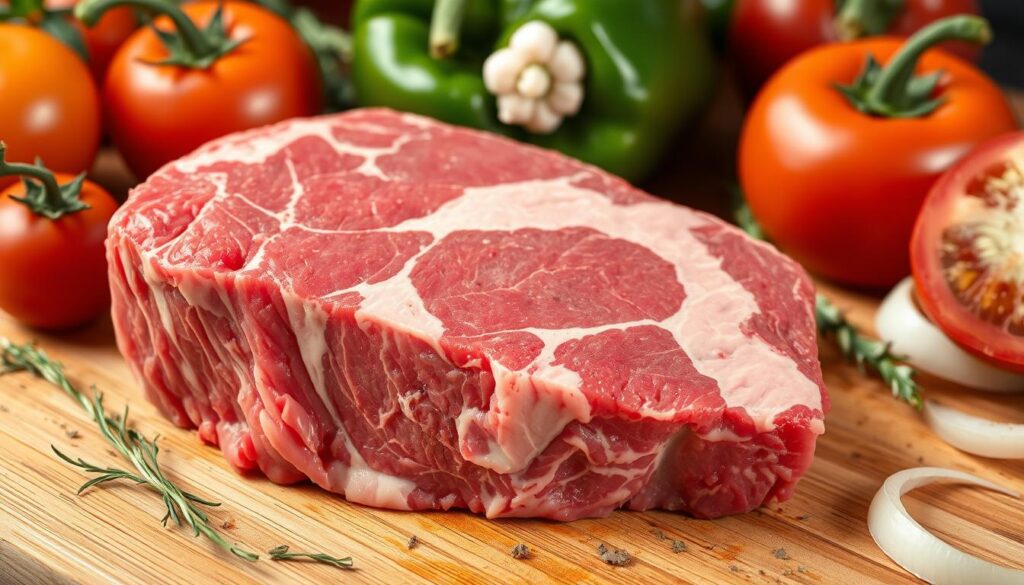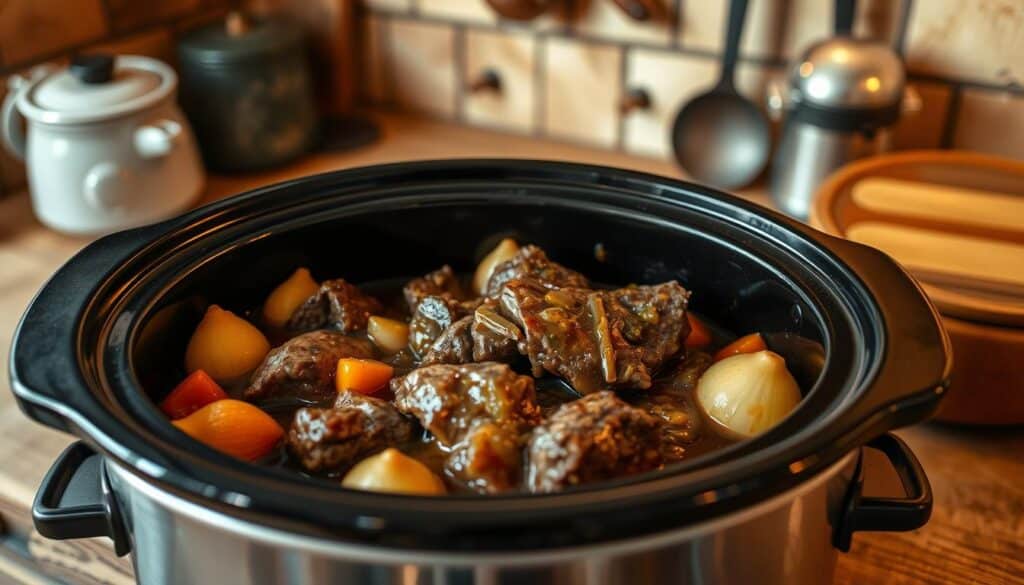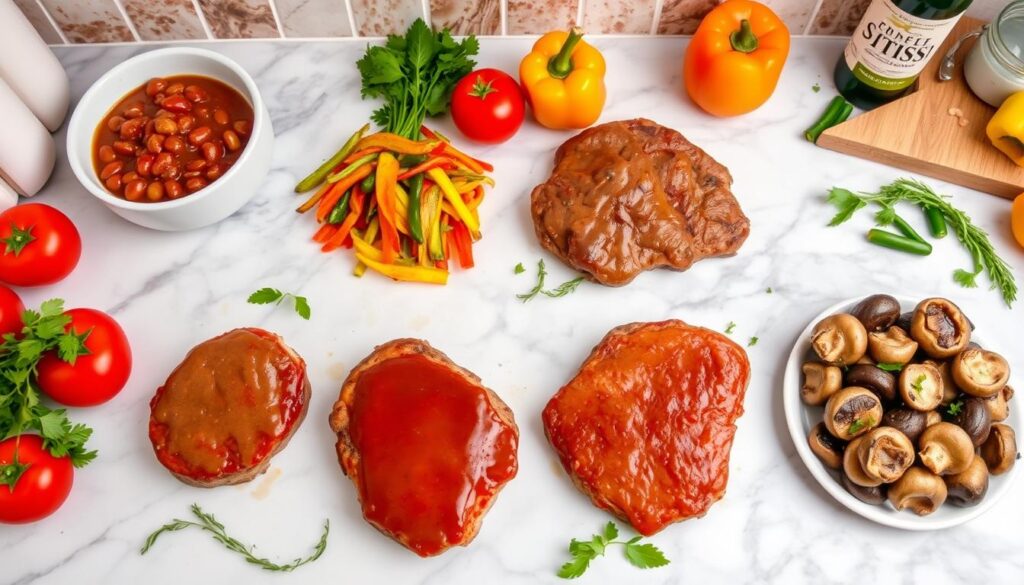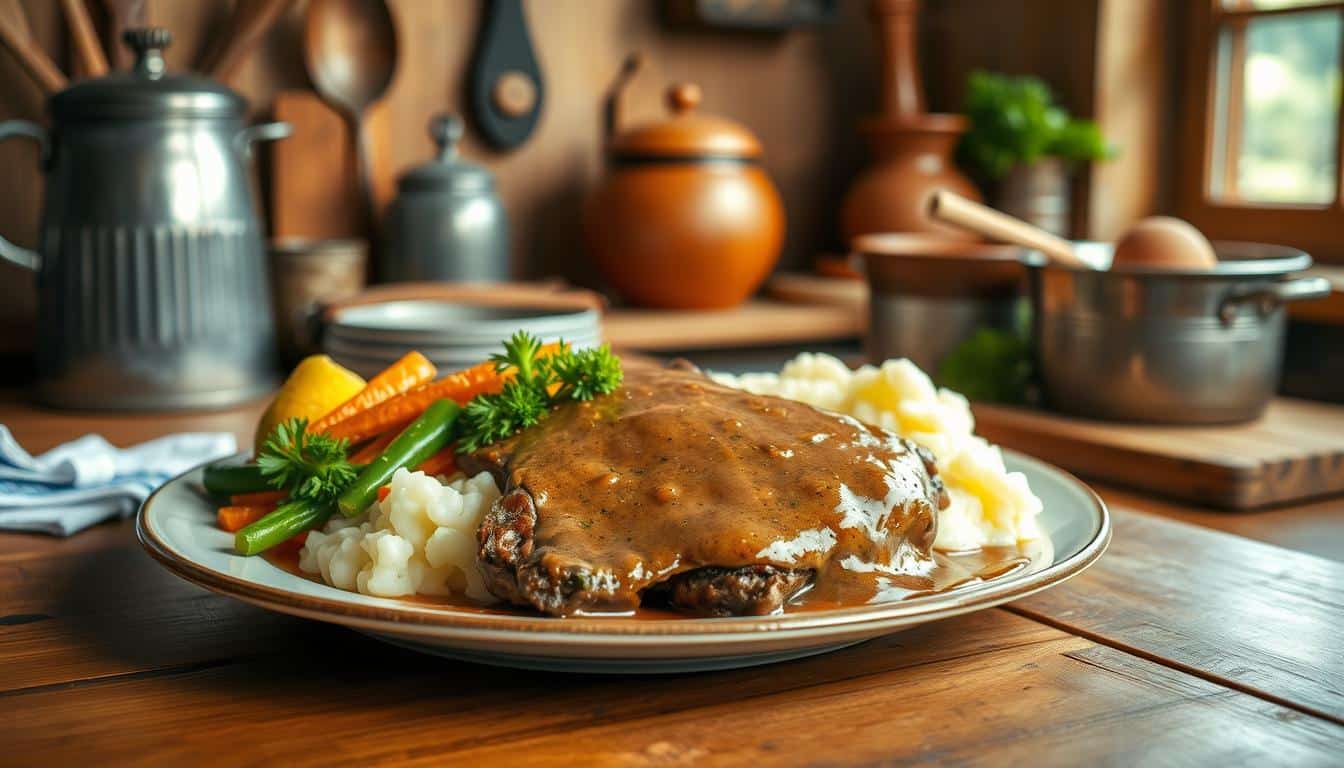Swiss Steak is a favorite comfort food that warms hearts and fills bellies. It’s a braised beef dish simmered in a rich tomato sauce. This dish has been a staple at family dinners for many generations.
Our Swiss Steak recipe is great for busy weeknights or lazy Sundays. It’s a budget-friendly meal that doesn’t lack in taste. The slow-cooking process makes every bite savory, pleasing both kids and adults.
Get ready to explore Swiss Steak. We’ll guide you through making this classic dish. It’s sure to become a favorite in your comfort food collection.
Understanding Swiss Steak: A Heritage Comfort Dish
Swiss steak is a beloved part of American cuisine. It has been a favorite at dinner tables for many years. It’s known for its tender meat and rich flavors.
Origins and History of Swiss Steak
Swiss steak became popular in the United States in the early 1900s. It was a way to make tough beef cuts tender. It became a favorite in homes for its taste and affordability.
Why It’s Called Swiss Steak
It isn’t from Switzerland. The name comes from the tenderizing method called “swissing.” This method makes tough meat tender by pounding or rolling it.
Traditional Preparation Methods
The classic way to make Swiss steak involves several steps:
- Choosing a tough cut of beef, like cube steak
- Tenderizing the meat by pounding or rolling
- Dredging the meat in seasoned flour
- Browning the meat in a skillet
- Slow cooking with vegetables and tomato sauce
This slow cooking turns tough meat into a tender, flavorful dish. It’s a true comfort food in American cuisine.
| Characteristic | Traditional Swiss Steak | Modern Variations |
|---|---|---|
| Meat Cut | Cube steak | Round steak, chuck steak |
| Tenderizing Method | Manual pounding | Meat mallet, rolling pin |
| Cooking Method | Stovetop slow cooking | Oven braising, slow cooker |
| Sauce Base | Tomato-based | Mushroom gravy, wine sauce |
Essential Ingredients for Perfect Swiss Steak
Making the perfect Swiss steak needs quality ingredients. We’ll show you how to pick the best parts for this tasty, affordable meal.
Selecting the Ideal Beef Cut
Cube steak is the main ingredient in Swiss steak. It comes from the top round or top sirloin. This makes it tender and quick to cook, keeping the meal affordable.

Vegetables and Aromatics
Bell peppers and onions add flavor to Swiss steak. They bring sweetness and depth. Tomatoes, fresh or canned, make the tangy sauce that Swiss steak is famous for.
Pantry Essentials
Your pantry has what you need for Swiss steak:
- All-purpose flour for dredging
- Beef broth for a rich gravy
- Worcestershire sauce for umami depth
- Garlic powder and paprika for seasoning
- Salt and black pepper to taste
With these ingredients, you’re set to make a tasty Swiss steak. It’s both filling and budget-friendly. The mix of tender cube steak, colorful bell peppers, savory onions, and tangy tomatoes makes a comforting dish loved by all.
Kitchen Tools and Equipment Required
To make Swiss steak, you need some key kitchen tools. These help make the meat tender and the gravy rich. Let’s look at the must-have equipment for your cooking journey.
A meat mallet is key for tenderizing the beef. It breaks down tough fibers, making the meat soft. For cooking, a Dutch oven is best. Its heavy bottom and tight lid are perfect for braising, blending flavors well.
If you like cooking without much effort, a slow cooker is great. It cooks the steak slowly, making it very tender. For quicker cooking, a pressure cooker is good. It cooks fast but keeps the meat tender.
Other useful tools include:
- Sharp knife for trimming meat
- Large cutting board
- Heavy-bottomed skillet for browning
- Wooden spoons for stirring
- Measuring cups and spoons
With these tools, you’re ready to make a tasty Swiss steak. The right tools can greatly improve your cooking. For more on kitchen tools, see this guide on essential equipment for keto crockpot meals.
Step-by-Step Preparation Guide
Let’s explore how to make perfect Swiss steak. We’ll cover key cooking steps to improve your cooking skills. You’ll learn about tenderizing, seasoning, dredging, and browning for a delicious dish.
Meat Tenderizing Techniques
Tenderizing is key for Swiss steak. Use a meat mallet to pound the beef. This breaks down tough fibers.
Another method is to score the meat with a sharp knife. Make a diamond pattern. This lets flavors get deep into the meat.
Seasoning and Dredging Process
Season your steak well with salt and pepper. Then, coat it in flour mixed with herbs and spices. This makes a tasty crust and thickens the sauce.
Dredging techniques are like those for chicken tenders. They give a crispy outside.
Proper Browning Methods
Browning adds rich flavor. Heat oil in a skillet over medium-high. Cook the steak for 3-4 minutes on each side until it’s golden.
This step makes a delicious crust and keeps juices in.
| Cooking Step | Time (minutes) | Temperature |
|---|---|---|
| Tenderizing | 5-10 | Room temp |
| Dredging | 2-3 | Room temp |
| Browning | 6-8 | Medium-high |
Learn these steps, and you’ll make Swiss steak that’s tender, tasty, and perfectly browned every time.
Creating the Perfect Gravy Base
The gravy base is the heart of Swiss Steak. We’ll show you how to make a rich, flavorful base. This will make your dish stand out. We focus on adding layers of taste and mastering the tomato sauce.
Building Flavors with Vegetables
Begin by sautéing diced onions, carrots, and celery. These veggies are the flavor base of our gravy. Cook them until they’re soft and smell great. Add minced garlic for more flavor.
Mastering the Tomato-Based Sauce
Now, we make the tomato sauce that makes Swiss Steak special. Use crushed tomatoes and tomato paste for a thick base. Add beef broth, Worcestershire sauce, and a bay leaf for extra flavor. Let it simmer slowly to blend the tastes.
| Ingredient | Amount | Purpose |
|---|---|---|
| Crushed Tomatoes | 28 oz can | Base of sauce |
| Tomato Paste | 2 tablespoons | Thickens and intensifies flavor |
| Beef Broth | 1 cup | Adds depth to gravy |
| Worcestershire Sauce | 1 tablespoon | Enhances umami notes |
The secret to great gravy is slow simmering. Let the sauce simmer for at least 30 minutes. Stir it now and then. This slow cooking makes the flavors richer and the sauce thicker. Your Swiss Steak will be perfectly coated.
Slow Cooking Tips and Techniques

Slow cooking makes Swiss steak tender and flavorful. We’ve learned how to braise it perfectly. Here are our top tips for a delicious slow-cooked dish.
Start by setting your oven to 300°F (150°C). This low heat breaks down the meat’s tough parts. It makes the meat soft and tender.
Choose a heavy-bottomed Dutch oven for even heat. Brown the meat, add veggies and liquid, then cover it. This keeps the meat juicy and the flavors in.
Slow cooking takes time, about 2-3 hours. Don’t check on it too often. This lets the heat stay in and cooks the meat faster.
“Low and slow is the way to go for maximum flavor development in Swiss steak.”
Turn the meat halfway through cooking. This makes sure it cooks evenly. If the sauce gets too thick, add a bit of beef broth or water.
The aim is to have meat that’s so tender it falls apart. When done right, slow cooking turns tough cuts into a delicious comfort food.
Serving Suggestions and Side Dishes
Swiss steak is best with the right sides. We have classic and modern options to make your meal better. Let’s look at some tasty pairings and plating ideas.
Classic Pairing Options
Mashed potatoes are a classic choice with Swiss steak. Their creamy texture goes well with the meat. Green beans add a fresh crunch and color to your plate.
For a different starch, try fluffy white rice. It soaks up the savory gravy nicely.
Modern Accompaniments
For a twist, try these updated sides:
- Roasted root vegetables
- Quinoa pilaf
- Sautéed kale with garlic
- Cauliflower mash
Plating Presentation Tips
Make your Swiss steak look great with these tips:
- Use a large, white plate for contrast
- Place the steak slightly off-center
- Arrange sides in small mounds around the meat
- Drizzle gravy artfully over the steak
- Garnish with fresh herbs for a pop of color
| Side Dish | Texture | Flavor Profile | Plating Tip |
|---|---|---|---|
| Mashed potatoes | Creamy | Buttery, rich | Create a smooth mound |
| Green beans | Crisp | Fresh, earthy | Stack in a neat pile |
| Rice | Fluffy | Neutral, absorbent | Use a ring mold for shape |
Storage and Reheating Guidelines
Storing and reheating Swiss steak leftovers is key for safety and taste. We’ve got some top tips for you to enjoy your meals safely.

Let Swiss steak cool down before you refrigerate it. Put it in an airtight container and chill it within two hours. It stays good in the fridge for 3-4 days.
Freezing is great for longer storage. Wrap the steak in plastic or foil, then in a freezer bag. Write the date and what’s inside. Frozen steak stays tasty for up to 3 months.
The oven is the best way to reheat. Heat it to 350°F. Put the steak in a dish, add some broth, cover with foil, and heat for 20-25 minutes. This keeps it moist and juicy.
- Microwave: For fast reheating, use a microwave-safe dish, cover, and heat in 30-second bursts, stirring each time.
- Stovetop: Reheat in a covered skillet over low heat, adding liquid if it’s dry.
Always check the steak’s internal temperature reaches 165°F when reheated. Follow these steps for safe and tasty Swiss steak leftovers.
Troubleshooting Common Issues
Swiss steak can be tricky to perfect. Let’s explore some common problems and their cooking fixes. This way, your dish will be delicious every time.
Texture Problems and Solutions
Tough meat is a frequent issue when making Swiss steak. If your steak feels like leather, it’s likely undercooked. Extend the cooking time by 30-45 minutes.
For overly dry meat, add more liquid to the pot and reduce heat. Remember, low and slow is the key to tender Swiss steak.
Gravy Consistency Fixes
Watery gravy can ruin the dish. To thicken runny sauce, mix a tablespoon of cornstarch with cold water and stir it in. For overly thick gravy, gradually add beef broth until you reach the desired consistency.
Simmer for a few minutes to let flavors meld.
Seasoning Adjustments
Over-seasoning is a common misstep. If your Swiss steak is too salty, add a peeled, quartered potato to absorb excess salt. For bland flavor, enhance with herbs like thyme or rosemary.
A splash of Worcestershire sauce can add depth without overwhelming the dish.
- For tough meat: Increase cooking time
- Watery gravy: Use cornstarch to thicken
- Over-seasoning: Add potato to absorb salt
With these cooking fixes, you’ll be well-equipped to handle any Swiss steak challenges. Don’t be discouraged by initial setbacks – practice makes perfect!
Variations and Modern Twists
Swiss steak has been around for a long time. But, creative cooks have made new versions of it. They’ve added different tastes and options for everyone.

Now, Swiss steak has flavors from around the world. Mexican versions add chipotle peppers and cumin. Italian ones use sun-dried tomatoes and herbs like basil and oregano. For an Asian twist, try soy sauce, ginger, and star anise in the sauce.
There are also vegetarian options now. Portobello mushrooms or seitan can be used instead of meat. They soak up the sauce’s flavors, keeping the dish hearty but meat-free.
| Variation | Key Ingredients | Flavor Profile |
|---|---|---|
| Mediterranean | Olives, capers, lemon zest | Bright, tangy |
| Indian-inspired | Garam masala, coconut milk | Warm, aromatic |
| Cajun | Andouille sausage, bell peppers | Spicy, smoky |
| Mushroom Lover’s | Assorted wild mushrooms | Earthy, umami-rich |
Healthier cooks might choose leaner beef or turkey. Some try new cooking methods like slow cookers or pressure cookers. These changes make Swiss steak quicker and easier for busy people without losing flavor.
Conclusion
Swiss Steak is a classic comfort food, great for family dinners and special events. It’s warm and inviting, with tender beef and a rich tomato gravy. We’ve looked into its history, ingredients, and cooking methods.
Choosing the right beef and slow-cooking it are key to making this dish delicious. The mix of tender meat, veggies, and sauce makes it unforgettable.
Swiss Steak goes well with mashed potatoes or new side dishes. It’s a versatile dish for any meal. Try it out and make it a favorite in your home. Your family and friends will love it.

